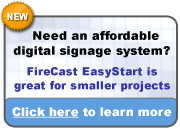David Keene at Digital Signage Magazine proffered a short post yesterday wondering about whether self-hosted digital signage systems (he calls them "Premise" systems) or those offered in the software-as-a-service (SaaS) model are better, and why. As he notes, people who doubt the SaaS model tend to believe that, "premise-based digital signage content management software packages are often more scalable, more secure, and more reliable because they are not based on a constant internet connection,". While tech novices might be easily swayed to believe these types of arguments, they're actually pretty poor indicators of the "quality" of a system for a particular application. They're also littered with presuppositions about how self-hosted and SaaS systems work. Here's a breakdown:
Unsubstantiated Claim #1: Premise systems are more scalable than SaaS systems
The fact of the matter: This one's easy. SaaS providers (like myself -- I'd like to point out that I have a vested interest here) live and die with their ability to provide service to their customers. I have literally thousands of devices checking in to my servers, for hundreds of clients. If there's any kind of problem, we hear about it very quickly. And our ability to win new business relies on our ability to quickly and inexpensively increase our capacity. How many networks hosting their own stuff can claim that? Very, very few.
Unsubstantiated Claim #2: Premise systems are more reliable because they don't depend on an Internet connection
The fact of the matter: In certain scenarios this might actually be really important. However, with the most common scenario (a player can't get onto the 'net to get content), I doubt there's really a difference in the majority of situations. Large files these days are usually downloaded ahead of time and stored on a local hard disk. And of course, if you don't have a good net connection, you won't be able to do streaming media, live data feeds, etc. regardless of what platform you use. If you have a network that you KNOW will never need to be connected to the Internet, I could see using this argument. Otherwise, it doesn't really resonate with most network applications nowadays.
Unsubstantiated Claim #3: Premise systems are more secure
The fact of the matter: This is the one that really irritates me when I hear it, because if the people claiming to be worried about security actually knew anything about computer security, they'd realize the flaw in their argument. That's because computer security essentially comes down to two things: technology and personnel. Any reasonably good product is going to have well-secured technology, including removing unnecessary programs, getting rid of common virus/hacking vectors, using recently updated or patched software, and implementing strong, non-obvious passwords. However, that's only half of the equation.
The other half is maintaining those systems over time, and this is where SaaS systems shine. At WireSpring we have full-time employees that do nothing but monitor our system status, read security bulletins, and continually maintain our software and servers. How many of those who host their own systems can claim that? We complete monthly security audits and maintain compliance -- at both the server and player level -- with strict standards like PCI-DSS and PABP. Again, how many self-hosted networks are going to go through the time, trouble and ongoing expense of that? I'd be willing to bet that it's a small percentage of the whole. Our servers are securely located in vault-like datacenters around the country, where physical access is limited via three-factor authentication, and armed guards patrol the perimeter. Meanwhile, I've had people tell me their "secure" systems are kept in a closet of their office.
Now admittedly, one place where self-hosted solutions *can* offer better security than SaaS solutions is when there's an "air gap" -- the network controlling the digital signs is PHYSICALLY disconnected from the Internet, and all activities like content upload and remote management must take place on this entirely separate network. In this case, it's physically impossible to compromise the network over the Internet (though local attacks are of course still possible). In reality, I'd be surprised if there were many such networks out there just because having such a gap is inconvenient.




 Anyway, according to
Anyway, according to 







 Ad Lab has a neat little post on 3D signage that isn't digital. It seems to be a large-format poster with some kind of embedded lenticular lens or something. I haven't yet seen the effect in person, but I imagine in the right environment it could look pretty cool.
Ad Lab has a neat little post on 3D signage that isn't digital. It seems to be a large-format poster with some kind of embedded lenticular lens or something. I haven't yet seen the effect in person, but I imagine in the right environment it could look pretty cool. Next, I'd like to direct your attention to
Next, I'd like to direct your attention to 
 I continue to be a fan of the work of Artisan Live, the digital signage-focused unit of Canadian ad/marketing firm Artisan Complete. Their content continues to be among the best I've seen in the retail digital signage space, and every year they win a bunch of new awards to prove it.
I continue to be a fan of the work of Artisan Live, the digital signage-focused unit of Canadian ad/marketing firm Artisan Complete. Their content continues to be among the best I've seen in the retail digital signage space, and every year they win a bunch of new awards to prove it. Subscribe to this blog
Subscribe to this blog Follow Bill Gerba on Twitter
Follow Bill Gerba on Twitter